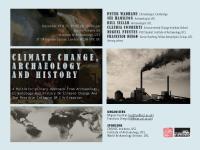Conferencia Cambio Climatico (Sue Hamilton - Bill Sillar)
CONFERENCE CLIMATE CHANGE, ARCHAEOLOGY AND HISTORY A Multidisciplinary Approach from Archaeology, Climatology and Hist
Views 49 Downloads 0 File size 2MB
Recommend stories
- Author / Uploaded
- MF2017
Citation preview
CONFERENCE
CLIMATE CHANGE, ARCHAEOLOGY AND HISTORY
A Multidisciplinary Approach from Archaeology, Climatology and History on Climate Change and The Possible Collapse of Civilization December 19 and 20 09:00 - 20:00 Institute of Archaeology Rapa Nui (Easter Island) making monuments, eco-changes and resilience (circa AD 1200-1600)
Food production and resilience to climate change in the Peruvian Andes Bill Sillar, Nick Branch and Stuart Black
Sue Hamilton
Director of the Institute of Archaeology, UCL December 20: 11:30 – 12:30
Institute of Archaeology, University of Reading December 20: 10:00 - 11:00
The central Andes is characterised by intensive agricultural production focused on the use of terracing and canal irrigation as well as herding. Food crops and domesticated animals have not only been the basis of household subsistence but also a major concern of colonising empires such as the Wari, Inca and Spanish. Past changes in the climate and socio economic organisation resulted in changes in the emphasis of agropastoral activities. But, equally changes in land, water, plant and animal management affected local and regional ecologies and transformed society. In this paper we raise questions about the degree to which previous examples of radical social change (e.g. the collapse of Wari/ Tiwanaku and the emergence of the Inca Empire) can be linked to climate change, and the degree to which the agricultural and social systems in the Andes today have sufficient resilience to withstand future climate change.
Interest in Rapa Nui’s iconic moai (statue) construction period is dominated by a focus on its demise. Words and phases such as ‘collapse’, ‘the island that self-destructed’, ‘ecodisaster’ and ‘disastrous European contact’ abound. There is a tendency to analyse the moai as isolated entities, rather than as elements of a dynamic interrelationship between people, landscape, places and architecture. A neglected mystery of Rapa Nui is the relationship between a remote i s l a n d ’s c h a n g i n g e n v i r o n m e n t a n d t h e emergence of an island-wide cosmology of constructing with stone. The presentation will pull together the diverse research avenues by which the UCL AHRC funded ‘Rapa Nui Landscapes of Construction Project’ has investigated the meaning, contexts and adaptive resilience of the moai- period construction activities. It offers a Polynesian framework of understanding place and environmental change.
ORGANIZERS Miguel Fuentes
[email protected] PhD Student. Institute of Archaeology, UCL
Dr. Francisco Diego Fras
[email protected] Senior Teaching Fellow Astrophysics Group, UCL
SPONSORS
CREDOC Institute, UCL Institute of Archaeology, UCL World Archaeology Section, IoA-UCL









